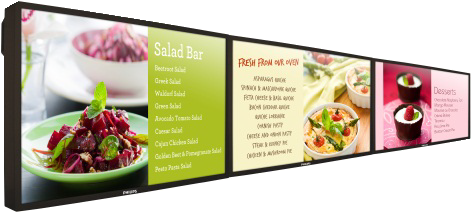Signage Displays
 Offering all the features and functionality of standard models, ENERGY STAR certified signage displays, also known as digital signage or commercial displays, come with more efficient and cooler-running panel technologies that can save you money.
Offering all the features and functionality of standard models, ENERGY STAR certified signage displays, also known as digital signage or commercial displays, come with more efficient and cooler-running panel technologies that can save you money.
- On average, signage displays that have earned the ENERGY STAR are 4 percent more energy efficient than conventional options.
- A signage display (31.5 – 60”) can save around $25 over its lifetime (assumption - left on 24 hours 365 days).
- A 3 x 3 video wall can save nearly $230 over its lifetime (assumption - left on 24 hours 365 days).
Most signage displays are covered under the ENERGY STAR certified displays specification. Displays that include a tuner or batteries designed to support mobility (e.g., electronic readers, battery-powered digital picture frames) are not covered.
Who uses signage displays?
Signage displays are generally used in offices (e.g., conference rooms, digital signage in lobbies), airports (e.g., flight information monitors), restaurants (e.g., menu boards), retail (e.g., outdoor advertising, video walls), and higher education. The vast majority of retailers (94%) use or have used digital signage to augment, change, or improve customers' in-store experiences.
Current Specification Effective Date: January 28, 2020
ENERGY STAR certified signage displays meet stringent energy efficiency requirements in On, Sleep, and Off Modes. The On Mode limit is a hyperbolic tangent equation, and power requirements vary according to screen area and maximum measured luminance of the display, with allowances for automatic brightness controll and embedded modules. The basic Sleep Mode power shall be less than or equal to 0.5 watts plus additional allowances for network connectivity, occupancy sensor, and touch functionality. For Displays that offer an Off Mode, measured Off Mode power shall be less than or equal to 0.5 watts.
Manufacturers sell two kinds of signage displays that tend to differ in lifespan, features, panel type, and connectivity. It is important to take these differences into account when choosing a display to ensure it meets your specific needs.
- Some signage displays ("consumer grade")have a lifespan of around 50,000 hours and use the same panel type as a consumer television but add features such as:
- Locking of front panel and IR remote
- Download acquisition mode (DAM) for hospitality TVs
- Portrait orientation
- PC compatibility2
- Expanded connectivity options such as PC inputs, USB, serial ports, RS-232, and VGA inputs in addition to RCA and cable inputs3
- Tougher enclosures (e.g., to withstand the high heat and grease of menu boards)4
- The other type of signage display ("commercial grade") is designed for 24/7 use and may have a lifespan of up to 100,000 hours. While generally more costly, these signage displays may be brighter, have better contrast ratios5, cool quicker and come with heavy duty power supplies and metal housings. They also can come with additional features such as:
- Video wall compatibility
- Touch screens
- Enterprise management capability
- Ceiling mounting
- Ability to host computers/graphics cards
- Advanced anti burn-in and image-retention features6
- Tempered glass face7
When developing your digital messaging, please consider the following:8
- Have A Plan For Your Digital Signs. Establish what content they are going to display on their screens and how it will helps your business. Some metrics are more obvious, such as featuring items on a digital menu board but others can be a bit harder to determine, such as corporate communication in offices or informational screens in a waiting room. Make sure you spend the time to identify the business needs that you have and how your signage can meet them.
- Choose the Right Displays Platform. Look at the type of content you want to show. Are you looking to do a simple playlist of videos or a mixture of images, videos and dynamic data? Different platforms excel at different approaches. Once you have the content questions answered, you can then start to determine the hardware and software that is best for playing back that content. The most important thing is that you look at the content management tools before buying.
2 www.ezdigisign.com/commercialvsconsumer.html
3 www.jcoproducts.com/swf/Top 5 reasons to buy commercial grade screens for digital signage.pdf
4 www.jcoproducts.com/swf/Top 5 reasons to buy commercial grade screens for digital signage.pdf
5 www.allsee-tech.com/news/digital-signage-why-use-commercial-displays.html
6 www.ezdigisign.com/commercialvsconsumer.html
7 www.allsee-tech.com/news/digital-signage-why-use-commercial-displays.html